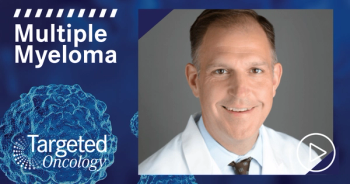
Golidocitinib Shows Potential in PTCL Post First-Line Therapy
In an interview with Targeted Oncology, Jie Jin, MD, discussed the need for a standard therapy in peripheral T-cell lymphoma and highlighted the potential impact of the JACKPOT26 study.
Golidocitinib demonstrated a favorable safety profile and encouraging efficacy in maintaining and deepening tumor response in patients with peripheral T-cell lymphoma (PTCL) who had undergone first-line therapy, according to findings from the JACKPOT26 (CTR20213318) trial.
Golidocitinib is a JAK1 selective inhibitor that has previously shown promising antitumor efficacy in patients with relapsed or refractory PTCL.
The JACKPOT26 trial included 48 patients with PTCL who achieved tumor response following first-line therapy. Once enrolled, patients were treated with golidocitinib at 150 mg once daily. Two cohorts were included in the trial, and investigators sought to evaluate the safety and antitumor efficacy of golidocitinib as maintenance therapy, along with the efficacy end points of patients who were 1-year and 2-year disease free survival (DFS) in cohort 1, and progression free survival (PFS), objective response rate (ORR), and duration of response (DOR) in cohort 2.
For all patients, the median duration of treatment was 7.1 months. With a median follow-up time of 8.1 months in cohort 1, the median DFS had not been reached, and a total of 86.7% of patients were still responding. Patients with nodal subtypes, including AITL, NOS, and ALK-ALCL, the median DFS also was not reached at a median follow-up of 8.3 months. Further, 82.4% of patients were still responding.
With a median follow-up time of 5.6 months in cohort 2, the median PFS had not been reached, and 66.7% patients were still responding. The ORR was 38.9% in cohort 2, and the complete response rate was 33.3%. The median DOR also was not reached in this cohort at a median follow-up of 3.7 months, and 85.7% of patients were still responding. Investigators estimated that the 6- and 9-month DOR rates were 100% and 100%, respectively.
For safety, 32 patients (66.7%) had ≥ grade 3 drug-related treatment-emergent adverse events (TEAEs) with the most common ≥ grade 3 drug-related TEAEs being neutropenia (37.5%), leukopenia (31.3%), lymphopenia (10.4%), and thrombocytopenia (6.3%). Most TEAEs were reversible and clinically manageable, and only 1 patient discontinued treatment with golidocitinib due to a drug-related TEAE. Moreover, there were no fatal outcomes resulting from treatment-related TEAEs.
Further investigation of golidocitinib in the first-line setting is warranted.
In an interview with Targeted OncologyTM, Jie Jin, MD, department of hematology, the First Affiliated Hospital, Zhejiang University School of Medicine, Hangzhou, PR China, Hangzhou, China, discussed the need for a standard therapy in PTCL and highlighted the potential impact of the JACKPOT26 study.
Targeted Oncology: What was the rationale behind JACKPOT26?
Jin: PTCL is a special kind of lymphoma that is different from B-cell lymphoma. It is heterogenous, difficult to treat, and is still lacking a standard-of-care. JACKPOT26 is designed as maintenance therapy for [patients with] PTCL who relapse from their frontline therapy. I think it is a very important strategy to keep the patients on treatment because the relapse rate for the frontline treatment is very high.
Who was included in the study and what end points were evaluated?
The inclusion criteria for the study is for patients who achieved tumor remission after their frontline therapy. There are 2 cohorts in this study. Cohort 1 is for patients who got complete remission after frontline therapy. There are 30 patients in this cohort. In cohort 2, we have 18 patients, and these are those who achieved partial response from frontline therapy. In total, we have 48 patients for this trial.
For demographics of this study, we included all kinds of subtypes. We included AITL, which represents 31.3% of the total study population, and also the PTCL NOS patients, which represents 27.1%, and NKT patients, representing 27.1% of the of the study population. All the patients have been included into the analysis of efficacy and safety.
The primary end point for cohort 1 is the 1-year and 2-year disease-free survival. The primary end point for cohort 2 is progression-free survival and the overall response rate. Other safety end points included general safety end points and severe safety end points.
Were there any notable challenges or unexpected findings?
There is no standard-of-care for maintenance therapy for [patients with] PTCL, so this is a very new strategy. All of the subtypes we included in this study benefit from this maintenance therapy, so we can see response from each subtype. There's a nice surprise in this study because for cohort 2, we included [patients with a] partial response. With that partial response, 1/3 patients achieved complete remission. In cohort 1 with 12 months follow-up, we still have more than 70 patients with disease-free survival, and for patients in cohort 2, the PFS is long.
What are the implications of this study's results on the current landscape of PTCL?
There's definitely an impact on clinical practice in this area because this is the first prospective trial that has ever been conducted for maintenance therapy and from the initial results, we can see that patients have a very long disease-free survival and progression-free survival. Through this study, we can anticipate that this study prolonged their relapse in this disease. This is an oral medicine, so it's a once daily administration, which is very convenient for the patients.
What are the next steps for this research?
From the results of the study, we will look forward to the first-line, frontline therapy to see if this drug can also increase the CR rate for the frontline therapy, and also for the relapsed and refractory patients. We'll see if this drug can provide salvage therapy for these patients.










































